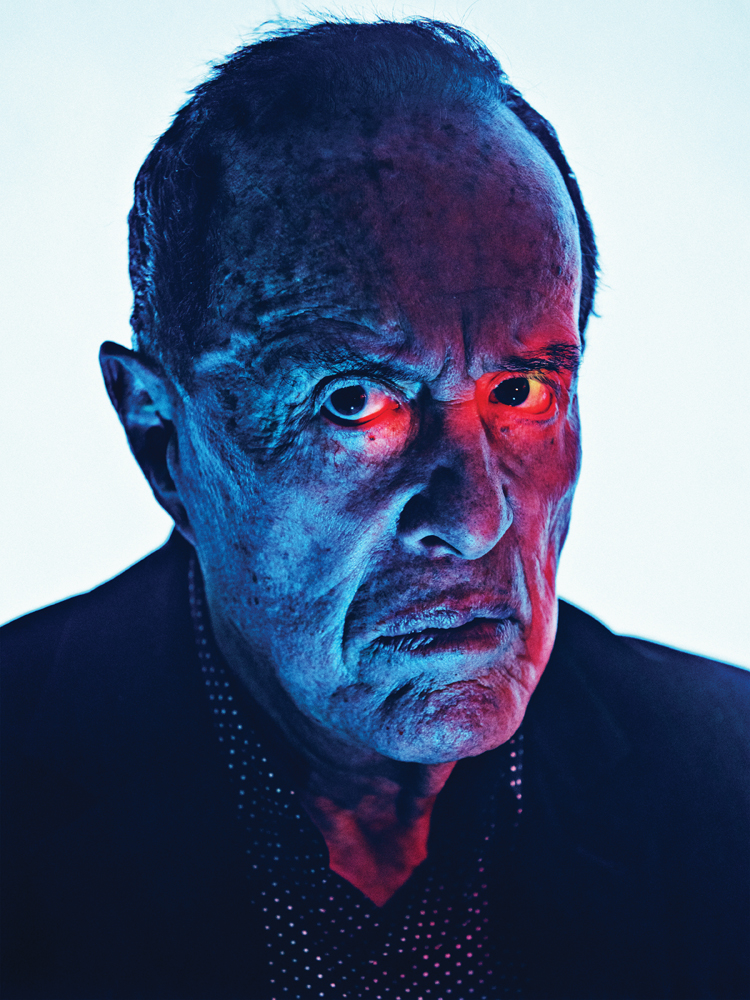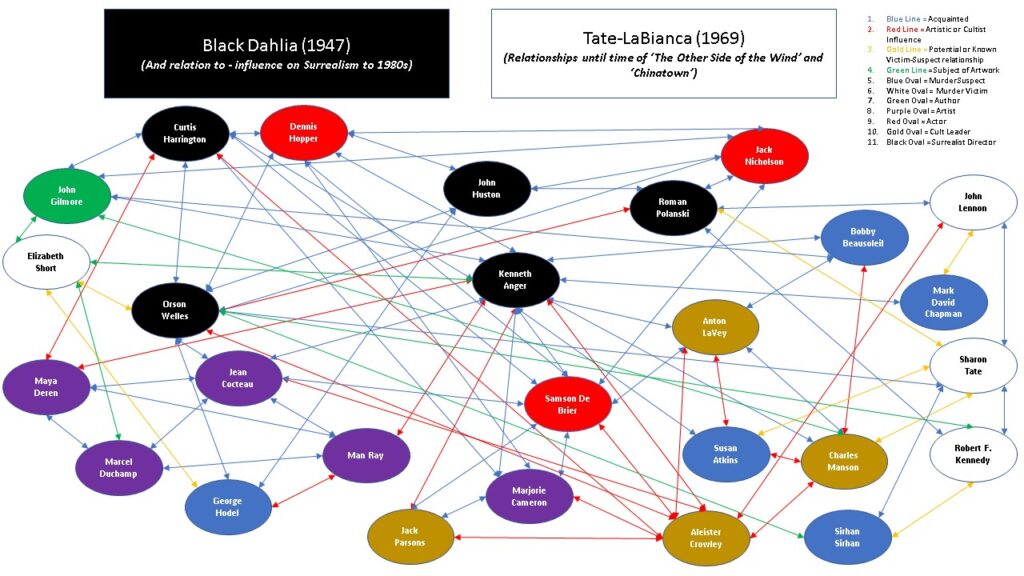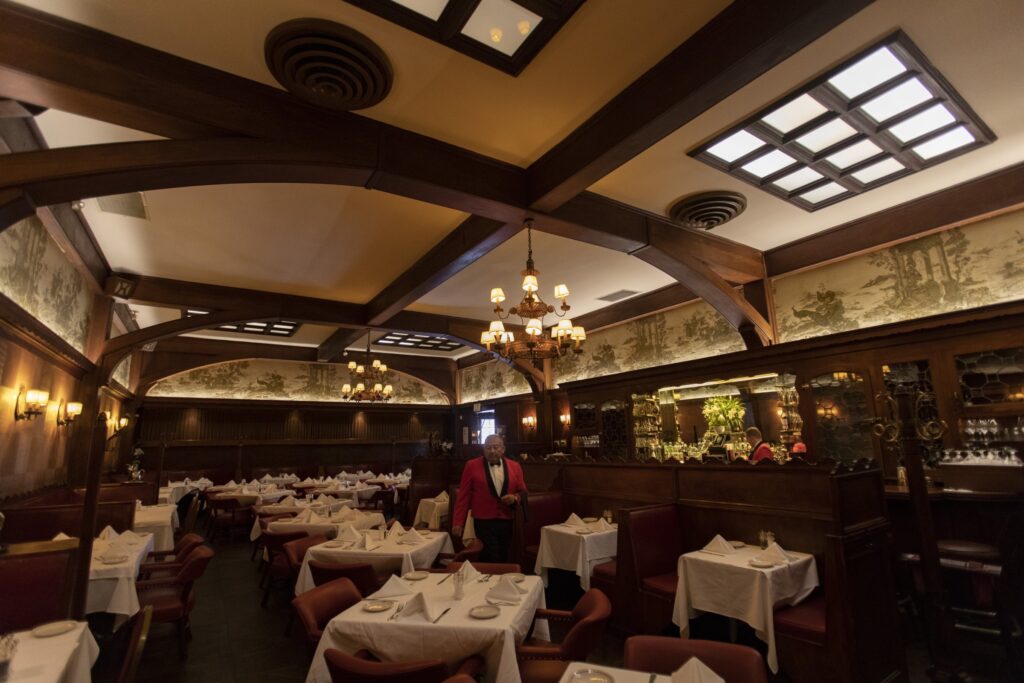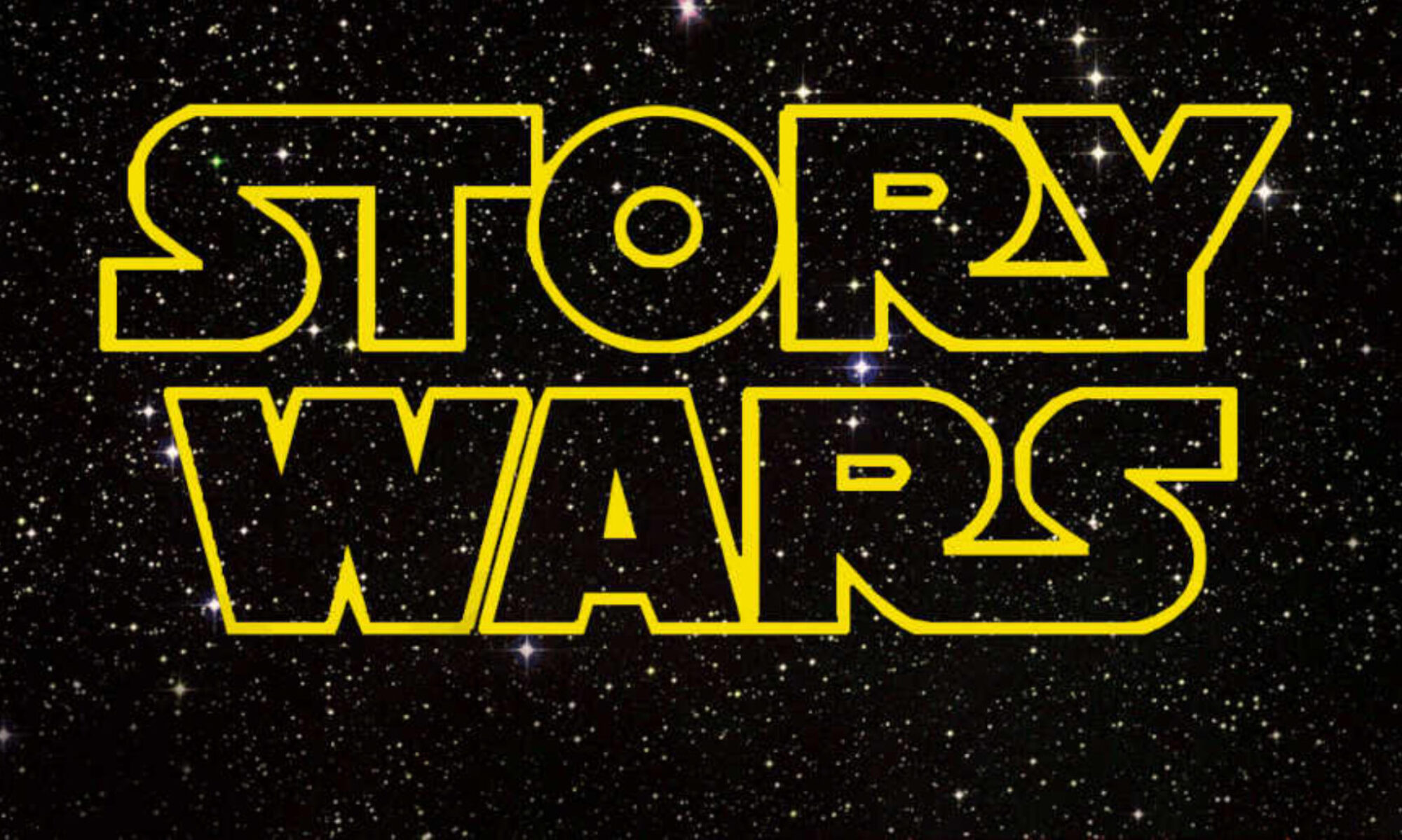Kenneth Anger (born Kenneth Anglemyer in 1927) seems to be a central figure in a network which connects Surrealist directors to the Black Dahlia and Tate-LaBianca murder cases. Active as a Hollywood artist since 1947 (the same year as Elizabeth Short, the Black Dahlia was murdered) he was later instrumental in building public interest in the case by posting graphic crime scene photos in his ‘Hollywood Babylon II’ book. Anger is very close in network to John Gilmore who was well-known for his writing on the case as well.
It is interesting that Anger too was close to the Surrealist school of art which is considered as a possible factor in the psychological profile of the Black Dahlia murderer. Anger’s film making was inspired by the Surrealist artist Maya Deren, and his 1947 film ‘Fireworks’ led to his romantic involvement with older French artist Jean Cocteau, whom he lived with in France . (Much of the Surrealist school – including Deren – can be placed close to Communism, and Anger also seems to have boycotted Hollywood in the HUAC era, despite Anger’s precedence of using Nazi images in his films.)
This technically places Anger in a contemporary network close to the Surrealist figures whom have been associated with the network of George Hodel — and the supposed influence of Man Ray’s ‘Minotaur’ on the secondary staging of Elizabeth Short’s body. Interestingly. the aesthetics of Short’s murder have also been compared in at least one essay to the opening scenes from Maya Deren’s ‘Meshes of the Afternoon’ (1943).
Anger was also a lifelong friend of John Gilmore’s lifelong friend Curtis Harrington – a famous filmmaker associated with the occult scene in Hollywood. In addition he was connected to at least 3 of the Manson Family murderers. In this sense, Anger straddles both the Surrealist network hypothetically associated with the Black Dahlia case and the ‘satanist-cultist’ network which might be associated with the Tate-LaBianca murders.

Anger filmed ‘Inauguration of the Pleasure Dome’ (1954) in the home of Hollywood occultist Samson Debrier (De Brier) along with Harrington, and Marjorie Cameron – the wife of deceased Aleister Crowley devotee (and potential Russian spy) Jack Parsons, who died in 1952. The film was based on a Crowelyan ritual.
As a side note, Anger even seems to have started conspiracy theories about Jack Parsons – implying that Howard Hughes (an apparently favored target of Communist propaganda back to the early 1940s) had Parsons killed. In the same interview with Aspen City News (cited below) when he had suggested police suspicion of his making snuff films, he’d also joked about Parsons as himself “being careless with the nitroglycerin”. Regardless, it seems Anger lived with Cameron for 2 years after Parson’s death, apparently capitalizing on it.
Anger has a long list of other ties to Crowley’s legacy as well, including working with Dr. Alfred Kinsey to view hidden frescoes in Aleister Crowley’s ‘Thelema Abbey’, or working with Jimmy Page at Crowley’s ‘Boleskine House’. Some rumor Anger (like L. Ron Hubbard) to be the actual successor to Crowley.
Anger notably was close to Anton LaVey, founder of the Church of Satan, who appeared in ‘Invocation of my Demon Brother’ (1969) and seems to even have facilitated a meeting between LaVey and Charles Manson at one point. Manson Family killer Susan Atkins was proximate to both LaVey and Anger. (Despite his more popular association with satanism than Anger, based on my interpretation of open source FBI files on Anton LaVey, he seems to have been more of a scapegoat and con-man out to make money than a real diabolical mastermind. One might wonder if Anger was the real influencer behind the scenes, being the employer of LaVey in film, being his conduit to figures associated with the Tate-LaBianca murders, etc.)
Of course, Bobby Beausoleil (also in Invocation of my Demon Brother) was another figure associated with the Tate-LaBianca murders and Manson; who was very close to Anger (potentially even his lover), and appearing in his films. (It may be noted here that long-time Anger associate John Gilmore also had excellent access to figures from the Manson Family, presumably due to this network and proximity to Anger.)
In a similar overlapping network of death, Anger claims to have been questioned by Mark David Chapman before he shot John Lennon in 1980, and that Chapman handed him bullets (Chapman indicated this claim of an interaction with Anger was true and implied their interactions had 3 parts according to Landis p. 228-229). (Lennon was shot outside the filming site for ‘Rosemary’s Baby’ in 1980, and he had been apparently known to Roman Polanski and Sharon Tate. It is interesting to note Anger’s major fall-outs with British rockers like Mick Jagger and Jimmy Page as well and the intentional rumor mongering he set against them.)
The Samson Debrier set around Anger also seems connected to popular motorcycle films which seem to have a literal association with the ‘Hell’s Angels’. Examples could be seen as Anger’s own ‘Scorpio Rising’ (1964), ‘Hell’s Angels on Wheels’ (1967) featuring Jack Nicholson, or Dennis Hopper’s ‘Easy Rider’ (1969).

According to Anger biographer Bill Landis, it seems that Anger specifically helped to mythologize the Hells Angels and vice versa via Scorpio Rising (although the bikers were initially concerned they would come to be equated with Anger’s homosexuality) (Landis, p. 118). Scorpio Rising was dedicated to “Jack Parsons, Victor Childe, Jim Powers, James Dean, T.E. Lawrence, Hart Crane, Kurt Mann, the Society of Spartans, the Hell’s Angels and all overgrown boys who will ever follow the whistle of Love’s Brother.”
When Hells Angels in England assaulted the crowd at a free Rolling Stones concert, Anger was there filming for Invocation of my Demon Brother, which Mick Jagger contributed the soundtrack to (Landis, p. 168). (Also in 1969 a similar incident seems to have occurred when Hells Angels hired by the Rolling Stones for security beat Meredith Hunter to death at a California concert and it was caught on film in the Rolling Stones documentary ‘Gimme Shelter’.)
Here is where the conversation turns to ‘snuff films’ or ‘snuff movies’, which are films which depict actual or acted out deaths – as in the snuffing out of a candle. The idea of a snuff movie seems popularly associated with writer Ed Sanders, who used the term in his book ‘The Family: The Story of Charles Manson’s Dune Buggy Attack Battalion’ (1971). Sanders claimed the Manson Family was involved in the documentation of their murders, although it has never been proven. (Notably Sanders seems primarily responsible for a modern view that ‘English Satanists’ connected to the Process Church of the Final Judgment – a Scientology offshoot – were responsible for the culture leading to Sharon Tate’s death, due to her overhearing something about Sirhan Sirhan.)
Despite the rumors of a Manson Family ‘snuff’ film never being proven, there have been many similar arguments about Kenneth Anger, some of which seem to tie back to the Manson Family as well as his involvement with the Hells Angels.
So far, I’ve found three such stories, but wouldn’t be surprised if there are more.
- Rumors circulated that a little boy named Godot Paulekas associated with the long-term Anger production of ‘Lucifer Rising’ had died in 1966, after falling through a skylight after having ingested a large amount of LSD, possibly during filming. (Anger recast this role later as Bobby Beausoleil.)The circumstances of the death of the child in the context of a snuff movie existing seem hardest to prove of the three examples.
- There are rumors that Bobby Beausoleil had stolen the early footage of Lucifer Rising. In Beausoleil’s account, Anger made these claims so he could distract from his inability to finish the film;
- Anger also published his own fake ‘eulogy’ in The Village Voice in 1967 after claiming Hells Angels had stolen his reels (Landis p. 158; this image of the eulogy is captioned that Variety published it).
- Presumably if death footage of Paulekas exits, it would be in some of this missing footage alleged to be stolen.
- In a 1965 interview with Aspen City News, Anger claimed that he was interrogated and released on suspicion of making a snuff movie after he dropped off footage of a sadomasochist beating at a local drug store for development. (His association with Alfred Kinsey seems to have protected him in this case and helped him get released.) Anger also claimed in the interview that footage for ‘The Love that Whirls’ had been destroyed because of the realistic portrayal of human sacrifice (Landis, p. 124 – 125).
- In this interview, Anger also had in his possession ‘magical’ bloodied clothing he said had come from a death on the set of ‘Kustom Kar Kommandos’ (1965); that film was never released because of the death. (This may serve as yet another example, although it isn’t rumored as a snuff movie.)
- Anger was actually rumored to have made the first ‘underground snuff film’ when, on the set of Scorpio Rising (presumably in 1963), a man crashed his motorcycle. Anger said of the incident: “I’m sorry the fellow was killed, but it wasn’t like I tripped him. It was a freak accident and he did die. I photographed him when he’s dead”.
Subjectively, the incident at 27:45 below in Scorpio Rising does not look staged – or necessarily fatal to me – but the sequence does seem to be glorified as the climax of the film in association with death imagery. We can only take Anger’s word for it that the person did actually die. It occurs after a Nazi-esque occult ritual is portrayed. The scene is accompanied by the Surfari’s track ‘Wipe Out’. If it is a recorded death it is subtle, except perhaps for people who may know the backstory. If you click the YouTube video below, it will start at the appropriate point in the film. (Notably some see Anger as the founder of the music video format.)
https://youtu.be/GDuu-m0-IjQ?t=1566
Objectively, it seems true that Anger is very well connected in Hollywood, and well connected to certain Hollywood tragedies too. One might perceive him as almost having an air of operating his own intelligence gossip agency based on his Hollywood Babylon books and penchant for bad mouthing those he’s had a falling out with. As a surrealist, magician, and self-mythologizer, it is hard to know where the truth about Anger’s own gossip may lie relative to all the death, and what may be urban legend. Certainly some of the rumors about him filming scenes involving actual deaths seem to be based in fact. More than one of his films seems to have been shelved or recast because of a death (or perceived one) on the set.
In general, I don’t believe coincidences, and Anger seems to have a lot of them to explain when it comes to conspiracism and death in Hollywood. I don’t think it unreasonable to wonder if his proximity to some of these crimes and apparently disinformative rumors may be evidence of his involvement in creating them. Hiding in plain sight as a ‘satanic communist pervert creep magician’ isn’t necessarily an unprecedented idea explored here.
In closing I also find it poetic in some way that David Lynch, who was strongly influenced by Anger as well as Maya Deren, claims to have seen photographs of Elizabeth Short taken by her killer – while in Anger’s favorite restaurant, the classic Hollywood eatery: Musso & Frank Grill (which I also wouldn’t know about if not for reading about it constantly in association with him – the place looks like a scene out of Stanley Kubrick’s ‘The Shining’).

The whole set of circumstances certainly raises the issue that perhaps it is unfair to associate snuff movies with Charles Manson (or even Roman Polanski) when satanic film innovator Kenneth Anger might rightfully deserve the artistic credits.
Cited: Bill Landis (1995); Anger: The Unauthorized Biography of Kenneth Anger
